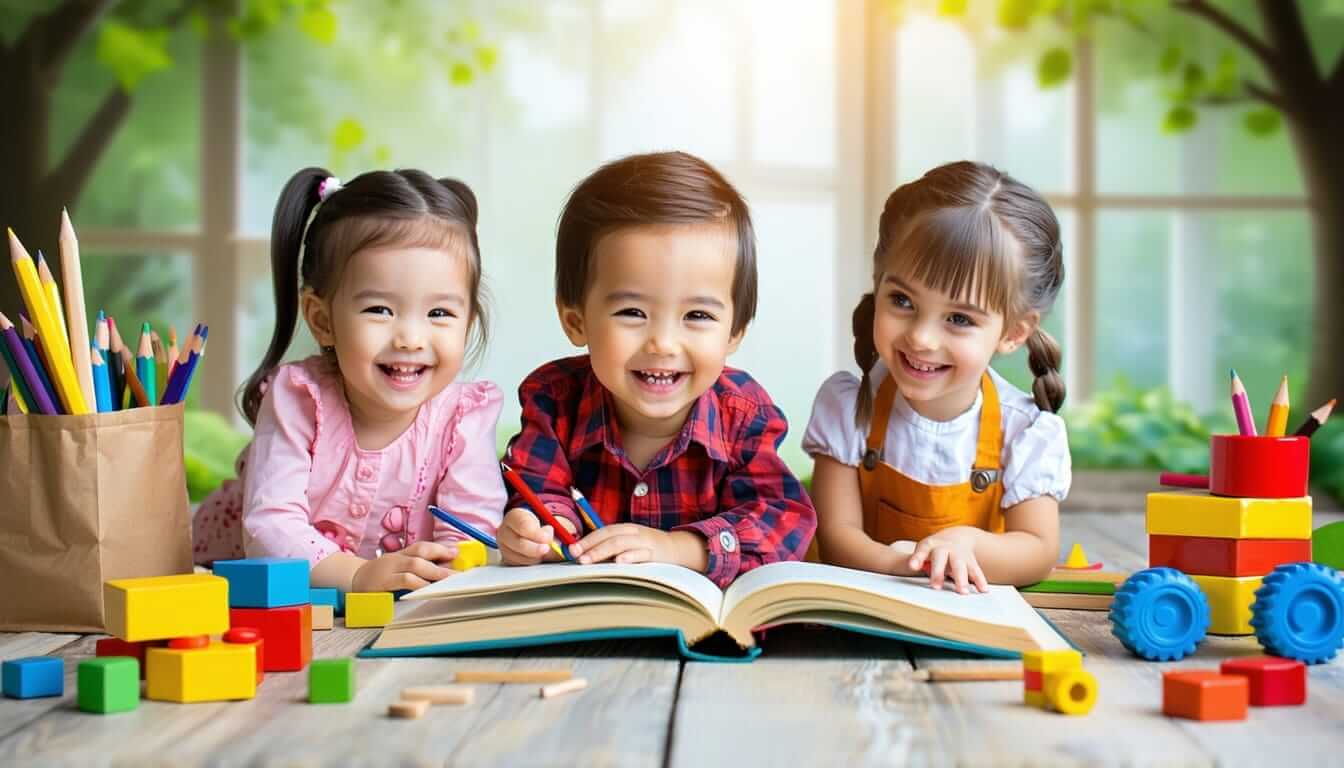The Power of Positive Communication
Alright, let’s cut to the chase. Kids learn a ton from how you chat with them. The way you talk, how you listen, and the positive spin you can put on things can have a huge impact on your child’s growth, particularly shaping their sunny outlook on life. Talking with your child isn’t just blah blah blah—it’s equipping them with skills to express themselves and tackle life with confidence.
Tips to Keep the Positivity Flowing
So, how do you get your kid thinking all positive and stuff? Let’s look at some easy-peasy stuff to try:
| Strategy | Description |
|---|---|
| Use Positive Words | Dial up the positivity with words that lift your kid up. Swap “Don’t worry” for “You’ve got this!” Make them feel like a champ! |
| Show You’re Listening | Prove you seriously care about their thoughts. Eyeball them, nod like Bobblehead, and respond to their stories. Make them feel important. |
| Throw Out Some Open Questions | Get them talking by asking questions that need more than a “yes” or “no.” Something like “What was the funnest thing today?” gets the brain gears turning. |
Make these small tweaks and before long, your kiddo is gonna feel like a million bucks—heard, respected and ready to take on the world. Hungry for more inspiration? Tap into our stash of tools for teaching optimism and resilience and fun thinking activities for kids.
Why Positive Talk is a Game-Changer
Talking things up isn’t just kid-friendly fluff. It packs a punch for your child and your family’s vibe:
- Supercharges Confidence: Kids soak up those supportive vibes, boosting their “I got this!” swagger.
- Helps with Mood Swings: Positive talk is like aloe for bumpy emotions. The more chill they are, the better they handle life’s curveballs.
- Bonds are Stronger than Ever: Good chats build trust super fast. It’s like building an emotional Wi-Fi signal that reaches future arguments or problems down the road.
When you chat positively with your little ones, you’re handing them a magnifying glass to see the silver linings. Keep on talking them happy and they’ll be power-waiting to tackle whatever’s thrown at them. Craving more positivity hacks? Look at our articles on sprucing up kids’ self-talk and growing emotional smarts through a positive mindset.
Teaching Affirmations
Understanding Affirmations
Affirmations are all about flipping those pesky negative thoughts on their heads with some good vibes. These simple statements can genuinely tweak your kid’s mental gears, thanks to this nifty thing called neuroplasticity (check out Old Dominion University for more brainy stuff). With a regular dose of affirmations, youngsters can build a positive outlook, chill-out a bit more, and tackle life’s curveballs with a smile.
Getting started with affirmations? Easy peasy. Have your little one stand in front of a mirror, lock eyes with their own reflection, and say those affirmations loud and proud. This practice pumps up their self-esteem and kicks off a lifelong habit of talking to themselves nicely, which is a big win for building confidence in children through positive mindset.
Incorporating Affirmations into Daily Routine
Weaving affirmations into your child’s daily grind can seriously up their happiness game. Here’s how you can sneak affirmations into their day without breaking a sweat:
| Time of Day | Activity | Example Affirmation |
|---|---|---|
| Morning | Kick off the morning | “I can handle anything today throws at me!” |
| Before School | Pep talk | I’m smart and ready to rock school!” |
| Before Bed | Wind down with positivity | “I’ve made today count, and I’m proud!” |
Remind your kid to shell out some affirmations during key moments. A morning pep talk sets a good vibe for the day, and a night-time affirmation helps wrap things up on a high note. For more ideas on how to boost mood with positive thoughts, dive into our tips on positive thinking activities for children.
You can even pair up affirmations with some chill meditation—it’s a game-changer! This combo can arm your kid better to roll with life’s punches, promoting not just a sunny mindset but also emotional balance (Old Dominion University). Dictate and deliberate, and watch as your child grows to tackle life’s surprises with a thumbs-up, proving that developing resilience in children through positive mindset isn’t just a dream.
By showing your child the ropes of affirmations, you’re handing them the blueprints to craft a strong and assured mindset that’ll stick with them for life.
Nonverbal Communication Techniques
When it comes to raising kids, the silent stuff—the eye rolls, the smiles, the “I’m listening” nods—can change how they see themselves and the world. If you want your child to grow up thinking, “Yes I Can!” pay attention to what you’re saying without words.
Importance of Body Language
Body language isn’t just a side dish; it’s the main course in family talks. If you’re telling your kid one thing, but your posture or face says another, you’re signing them up for a confusion class. It’s like trying to run a computer on two different programs at the same time.
Here’s the shorthand on nonverbal cues:
| Body Language Cue | What It Says |
|---|---|
| Eye Contact | “Hey, I’m really paying attention.” |
| Facial Expressions | “Feeling happy, sad, or just plain ‘meh’?” |
| Posture | “I’m open to what you’re saying.” |
| Touch | “A good hug says more than words.” |
Don’t just tell your kid how to chat effectively—show them. Keep those eyes locked, and let your face do the talking, backing up your words with that reassuring smile.
Building Emotional Awareness
If nonverbal communication is a cake, emotional awareness is the flour. You gotta know what’s cooking inside your head before the world gets a whiff of it. If you’re stressed, chances are you might miss a few cues or send some mixed signals. Nobody wants to play “Guess My Mood” every time there’s a conversation (HelpGuide.org).
Let your child in on your little zen tricks like breathing or taking a quick pause before speaking. Talk about emotions as if they were on the daily forecast. “Looks like a cloudy afternoon with a chance of grumpiness.” The practice helps the kid catch on to emotional intelligence and decode body language like a pro.
By mixing these silent skills into everyday chats with your kid, you’ll boost your interactions and help them walk a straight path to positive thinking. And hey, if you’re looking for more tips, swing by our resources on teaching children optimism and resilience and promoting positive self-talk in children.
Active Listening Skills
Active listening can really change the way you and your kiddo connect. Think of it as your secret weapon to build a positive mindset and communication bridge with your child. With a dash of patience and lots of engagement, you’re set to become a communication wizard in their eyes.
Key Stuff About Active Listening
Getting the hang of active listening with your child is pretty straightforward once you know what to look out for:
| Thing to Do | Why It’s Cool |
|---|---|
| Totally Tune In | Forget your own buzz for a bit and pay attention to what’s going on in their world. |
| Notice the Little Things | Keep an eye on those tiny cues – like how they stand or look – that say more than words. |
| Eyeball Connection | Locking eyes shows you’re really there in the convo and not just daydreaming. |
| Ask Away | Ask stuff that gets them talking, not just nodding or shaking their head. |
| Echo Back | Repeat in your own words what they’ve said so they know you’re on the same page. |
| Hang Back on Judging | Give them space to let it all out without jumping to conclusions. |
These tricks help you really connect, making your child feel comfy enough to share big feelings or random thoughts. For some fun ideas on staying optimistic, check out our positive thinking activities for kids.
Magic of Great Chat
Getting real good at chatting with your child can unlock new levels of understanding and trust. Here’s some savvy stuff you might want to add to your playbook:
-
Walk in Their Shoes: Dive deep into their world and feelings—it’s like giving them a hug without using your arms! They’ll feel less alone and more seen, which is awesome for their confidence. Dive deeper into teaching your kids to stay sunny and tough.
-
Keep Them Talking: Use cool words to praise how they’re sharing or expressing themselves. They’ll love the kudos, and it’ll nudge them to open up more.
-
Drop Some Feedback: Talk about what you’ve heard and feel about it all. It’s like saying they and their feelings matter and should be front and center.
-
Make It a Habit: Treat every chat like a practice session. This builds a fortress of trust over time, making it easier for them to spill their thoughts.
Every convo with your child adds a brick to their emotional smarts and social grace. For a deeper dive into how you can raise their confidence levels through positive vibes, check out boosting confidence in kids through the power of positivity.
By mastering these active listening moves, you’ll be creating a warm home base for them to drop by whenever they need to share something on their mind.
Nurturing Positive Conflict
Getting your kid to see conflict as more than just drama can work wonders for their social skills. It’s all about flipping the script—seeing conflict as a chance to grow rather than something to dread. Conversations and communication play key roles here.
Fostering Healthy Team Dynamics
Creating a chill space where everyone feels they’re heard is super important. When kids are comfy sharing their thoughts, teamwork gets a massive boost. They start to recognize the value in different opinions, leading to smarter choices. Opinions are like belly buttons—everyone’s got ’em, and seeing their worth can empower kids to focus on solutions (HRDQ).
A good mix in a team involves kids understanding that conflict can actually be the secret ingredient to cracking tough problems. When they hash it out respectfully, they realize it’s not just about tackling issues but about doing it together. This open vibe sets your child up to talk better, tune into their feelings, and sharpen their people skills, underpinning a positive mindset and effective communication in children.
| Benefit of Positive Conflict | Description |
|---|---|
| Open Discussions | Everyone can speak up without worrying about getting shot down. |
| Improved Problem Solving | Different viewpoints can spark the best ideas. |
| Stronger Relationships | Talking things through strengthens the bonds. |
Constructive Feedback Principles
Giving feedback isn’t just about pointing out what’s wrong—it’s a way to help kids blossom personally and socially. Feedback helps keep the peace and lets the group work better together. Nipping issues in the bud stops things from spiraling, creating a harmonious vibe.
When sharing feedback, keep in mind:
- Timeliness: Deal with stuff right away to keep the chat open and relaxed.
- Respect: Talk straight but keep it kind to build trust.
- Clarity: Spell things out clearly but gently for real impact.
When this becomes second nature, kids pick up a knack for handling conflicts. Learning to roll with feedback grows their resilience and boosts their self-esteem through teaching children optimism and resilience.
So, when you get your kid to welcome feedback, you plant the seeds of a growth mindset and highlight the magic of resolving disagreements. This is a vital part of nurturing a positive mindset in child development, setting them up with skills that’ll stick for life in teamwork and talking.
Nonviolent Communication Method
Principles of NVC
Nonviolent Communication (NVC), cooked up by Marshall Rosenberg back in the swinging ’60s, makes chit-chat less about barking and more about connecting. It’s built on four things: observation, feeling, need, and request. These are not just fancy words—use ’em to say what you really mean, skip the angry looks and grunts, and get relationships on the up and up.
| Principle | Description |
|---|---|
| Observation | Stick to the facts, ditch the judging and guessing games. |
| Feeling | Open up about emotions—no shame in your game. |
| Need | Pinpoint what’s buzzing underneath those feelings for some soul-searching goodness. |
| Request | Ask nicely with friendly intentions, no bossing around. |
Dabble with these in your talks and, voilà, kindness and trust bloom. NVC ain’t just grown-up stuff; it’s perfect for getting the kiddos on board the good vibes train too.
Applying NVC in Relationships
Set your kiddos up for smooth talking by slipping NVC into the daily grind. Here’s the 101 on using NVC with your little ones:
-
Talk the Talk: Swap blame-talk for NVC lingo. Instead of, “You never clean your room,” try, “Looks like your room’s a mess. It’s got me stressed ’cause I dig things neat. Could you tidy it a bit?”
-
Get ‘Em Thinking: Help your kiddo break down their feelings and wants, with questions like, “What’s that situation messing with your mood?” or “What’s gonna make things better now?”
-
Teach Emotional Smarts: Show them how to label feelings and express them through chats and play. It opens up doors for heart-to-hearts.
-
Solve Squabbles: Use NVC to iron out tiffs by having your child share what they’re feeling and wanting, while really hearing out the other side.
By putting NVC into practice, you lay down the tracks for smooth, heartfelt chats. It’s not just about stamping out squabbles; it creates a warm, cozy patch for growing emotions and empathy.
Dive deeper into boosting your child’s chat skills with a positive twist. NVC paves the way to a cool boost in emotional know-how and bouncing back from life’s bumps. Peep more goodies like helping kids with the self-friendly talk and teaching them the magic of thinking happy thoughts.




